2015 Montlhéry Vintage Revival report
Just when you thought you had seen it all
Author
- Mattijs Diepraam
Date
- May 25, 2015
Related articles
- Le Mans - A bigger-than-life experience, 2014 Le Mans Classic report, by Mattijs Diepraam
- Monaco - In Grand Prix heaven, 2014 GP Monaco Historique report, by Mattijs Diepraam
What?Richard Brasier Where?Montlhéry When?2015 Montlhéry Vintage Revival |
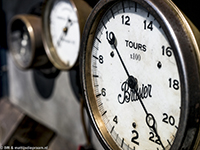 |
Why?
Whoever regrets that the Monaco GP Historique – and the Le Mans Classic for that matter – only takes place in even years should think again before electing to stay at home instead of venturing to France for the May holidays. The Pau event is an interesting alternative to any motor racing aficionado, but so is the Vintage Revival at the classic track of Linas-Montlhéry. There is no racing involved in the two days that form this magnificent spring event, but the vehicles and the people make up for it and more – as does the track itself. The Montlhéry Vintage Revival is the planet’s non-plus-ultra for anyone fascinated by pre-war rolling machinery propelled by any kind of drive. And if you’re not fascinated yet, you will be.
The Montlhéry speed bowl south of Paris is a place of epic proportions, especially when the sun is mercilessly bearing down on it from a blazing blue sky cut in pieces by the dozens of con trails that betray the vicinity of the city’s Orly airport. That was precisely the situation when the Vintage Revival had its presence felt at the historic French track. In its heyday, Montlhéry used to combine an adult-size banked oval with a road circuit that boasted a huge loop stretching miles away from the track’s central area. The loop has long since gone, but in this configuration – half of the oval paired with the entire road circuit – Montlhéry used to host several ACF GPs, the erstwhile French GP. Its challenge sorted the men from the boys, hence the winners’ list reading as a who’s who of twenties and thirties Grand Prix racing: Robert Benoist and Louis Chiron were both double winners. Achille Varzi, Giuseppe Campari and Rudi Caracciola were victorious too, while Montlhéry famously claimed the life of Antonio Ascari.
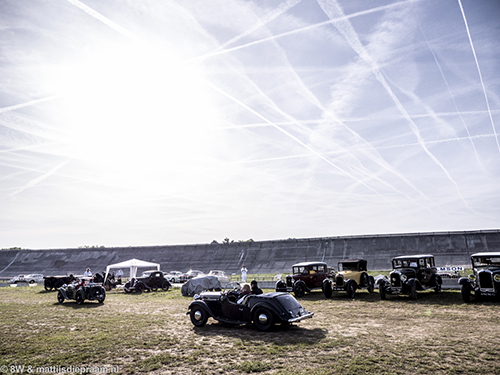
Blazing skies over the Montlhéry speed bowl. (photo 8W)
In years that the ACF awarded their GP to another circuit, Montlhéry still hosted the Coupe du Salon and Paris 1000km sportscar races, as well as welcoming dozens of speed-record addicts to its full oval, at a time when Brooklands was past its prime. Bikers also flocked to Montlhéry, especially when it was time for the Bol d’Or, a famous long-distance event that was held until 1970.
As far as four-wheeled competition was concerned, however, the autodrome soon had to cede to Reims and Rouen-les-Essarts as the predominant French circuits. On a national level, it continued to welcome French GTs and touring cars until well into the nineties, albeit on a circuit with a very much shortened loop, but still including a part of the oval. It’s much more than could be said of Brooklands, Miramas, Sitges-Terramar or Monza.
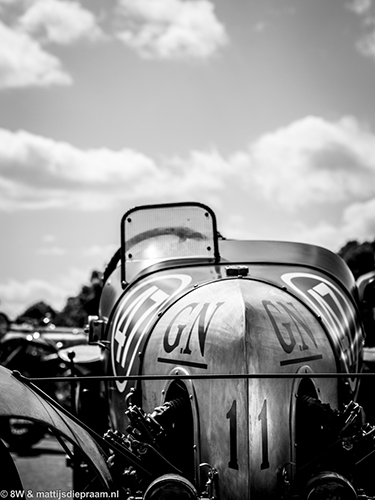
The impressive GN-Salmson cyclecar. (photo 8W)
So it’s with a mix of nostalgic sadness and proud exhiliration that we watch an amazing assembly of pre-war cars thunder along the wall-of-death of Montlhéry today. On the one hand, the entire oval is still there. On the other hand, half of it is disused, and not for nothing, since it is in such a bad state that racing on it would be even more dangerous than it’s ever been. The concrete of the other half is crumbling away too – it’s not difficult to see the moment in future when the decision needs to be taken to prevent cars from ever climbing to its heights.
Then again, it makes for the perfect stage for a celebration of the greatest and maddest examples of pre-war (and pre-Great War) engineering. The Vintage Revival opened the Montlhéry gates to over 300 cars, tricycles and bikes – many of them from abroad, but most of them hailing from France itself, which must surely be regarded as the nation with the largest number of ‘mad-scientist’ – others would say innovative – car designers. Divided into six ‘plateaux’, all cars were given a go four times – two times each day. They were supplemented by two groups of motorized bicycles and ‘motocyclettes’, the latter group consisting of a hotchpotch of pre-World War I mopeds and motorbikes.
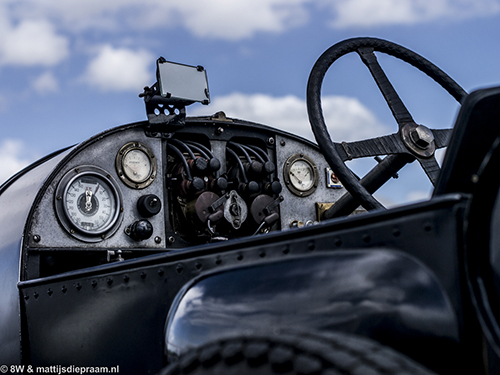
This is what the office of a Bugatti T13 Brescia driver would look like. (photo 8W)
During both days, the paddock area was bustling with activity, and not just around the cars themselves, as spare-part sales were booming. Unlike the Goodwood Revival, the Montlhéry Vintage Revival does not strictly enforce a dresscode but several visitors were still seen giving it a fair attempt. With regards to noise regulations, however, Montlhéry does maintain a stringent policy, so both days didn’t see the need for earplugs.
Group A was an all-French group of small-sized race cars from the twenties, ranging from Amilcars and BNCs to Salmsons. Salmson was the feature brand of the event, and dozens of them turned out, including some of the strangest Salmson-engined cars, such as the boat-tailed Bignan Val Sport with its aptly named ‘Skiff’ body.
More Salmson derivates including several foreign ones were seen in Group B, such as the GN-Salmson cyclecar with its rocket-shaped tail and a remarkable spare-wheel solution. These were joined by nippy Bugatti Brescias and MG TAs, all of which had no qualms circumnavigating the three chicanes that for safety reasons blighted a full run along the oval.
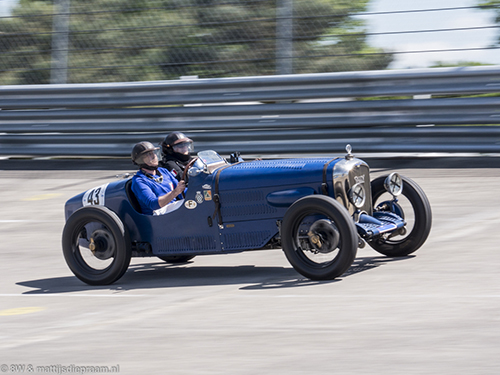
The Salmson-engined Rally car powering towards the finish line. (photo 8W)
A lot of streamlined bodies turned Group C into quite a sight, especially against the background of the old pit building which, contrary to Goodwood’s equivalent, is in fact old. More Salmson machines featured in this group, including a Rally NCP with Salmson engine – not a rally car, but a car created by the French ‘Rally’ marque.
Group D was entirely devoted to tricycle cars, and anyone believing this would be an all-Morgan-JAP affair couldn’t have been more wrong. Who has ever seen a BMW boxer-engine threewheeler before?
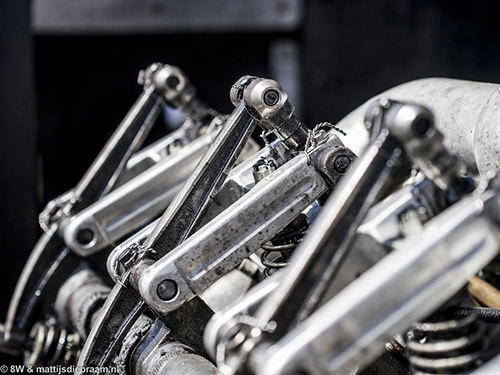
The massive valve actuators of the behemoth Mors machine. (photo 8W)
The fastest cars of the meeting came in Group E, and the ex-Laszlo Hartmann Maserati 8CM in Hungarian national colours was visibly the fastest of them all. It was joined by swarms of Bugattis while the monstrous aero-engined GN contraptions proved as quick as they were impressive to watch. Other lovely cars in this group included an MG PB, Amilcar CO, Aston Martin Inter and MG K-type Magnette.
The high-capacity veteran machines ran in the final group, and most of them were sensational. Most visitors gave top marks to the Mors and the Austin Hall Scott Aero but the Mercedes GP cars made their presence felt as well. We loved the Richard Brasier and Sizaire et Naudin too, the latter still boasting its Charles Jarrott dealer plate.
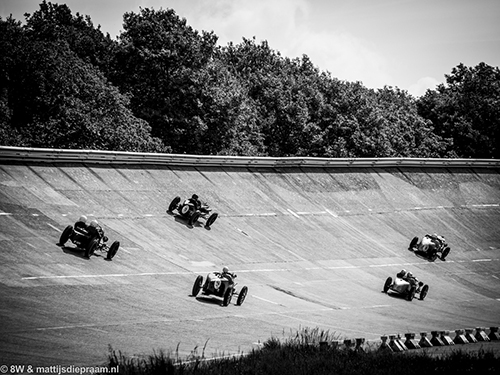
Time travel in progress. (photo 8W)
If some of the cars already mentioned were outlandish enough, they were utterly conventional compared to some of the stuff that came out in the ‘motocyclette’ groups. The Bedelia, for instance, was once created to evade the Parisian edict against cars entering the Bois de Boulogne, a purpose in itself already. The way in which it was done, however, was utter madness, the passenger sitting in the front of a V-twin-engined car driven by a belt system using Variomatic-style pulleys…
Gabriel Voisin’s creations were works of art first, and cars only after that, but the one Voisin that made all the other Voisins present look like, erm, cars, was the lozange-shaped contraption designed by Maurice Pain that was meant to be completed just ahead of World War II. Using the only 1:5 model still remaining, a replica was made of the 1938 vehicle that was to be driven by a two-stroke engine. The replica is powered by a 620cc DKW engine and weighs in at 375kg.
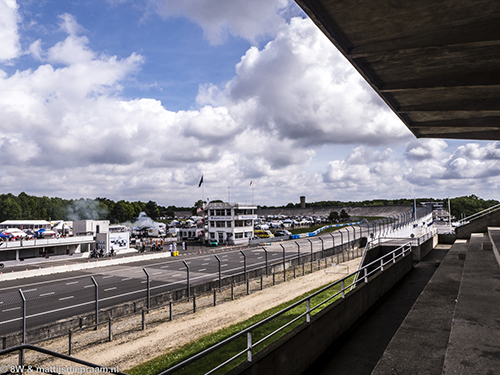
A glorious sight: the Autodrome Linas-Montlhéry is the perfect background to the Vintage Revival. (photo 8W)
That almost made the 1897 Hurtu Tricar look less of an anomaly. This Léon Bollée-derived threewheeler had a watercooled 882cc one-cylinder engine producing the amazing output of 3hp at 800rpm. It was the first car that was given the epithet of ‘voiturette’.
And then, if you thought you had seen it all, there was the 1913 Leycat Helica to surprise you. Yes, this radial-engined ‘car’ actually drives, but wit hits propulsion actually coming from a propellor you expect it to take to the skies in a minute, if not for the lack of wings.
Long may the Montlhéry Vintage Revival continue – as long as the Montlhéry track manages to prolongue its existence, in fact. We can’t remember an event in which we uttered the word ‘unbelievable’ as much as in these two days in May. Who needs the Monaco GP Historique in uneven years when you can have this?
